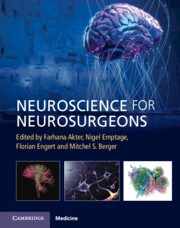Book contents
- Neuroscience for Neurosurgeons
- Neuroscience for Neurosurgeons
- Copyright page
- Contents
- Contributors
- Section 1 Basic and Computational Neuroscience
- Chapter 1 Neuroanatomy
- Chapter 2 Cerebral Autoregulation
- Chapter 3 Neuroimmune Interactions
- Chapter 4 Anatomy and Physiology of the Neuron
- Chapter 5 Synaptic Transmission
- Chapter 6 Sensory Pathways
- Chapter 7 Somatosensory and Somatic Motor Systems
- Chapter 8 Neuron Models
- Chapter 9 An Introduction to Artificial Intelligence and Machine Learning
- Chapter 10 Artificial Intelligence in Neuroscience
- Chapter 11 Probability and Statistics
- Section 2 Clinical Neurosurgical Diseases
- Index
- References
Chapter 1 - Neuroanatomy
from Section 1 - Basic and Computational Neuroscience
Published online by Cambridge University Press: 04 January 2024
- Neuroscience for Neurosurgeons
- Neuroscience for Neurosurgeons
- Copyright page
- Contents
- Contributors
- Section 1 Basic and Computational Neuroscience
- Chapter 1 Neuroanatomy
- Chapter 2 Cerebral Autoregulation
- Chapter 3 Neuroimmune Interactions
- Chapter 4 Anatomy and Physiology of the Neuron
- Chapter 5 Synaptic Transmission
- Chapter 6 Sensory Pathways
- Chapter 7 Somatosensory and Somatic Motor Systems
- Chapter 8 Neuron Models
- Chapter 9 An Introduction to Artificial Intelligence and Machine Learning
- Chapter 10 Artificial Intelligence in Neuroscience
- Chapter 11 Probability and Statistics
- Section 2 Clinical Neurosurgical Diseases
- Index
- References
Summary
A thorough knowledge of gross human neuroanatomy is important in understanding basic and clinical neuroscience. In this chapter we describe the key anatomical features of the human brain followed by a discussion on the main developmental processes and signaling mechanisms of neurogenesis and embryology. Finally, we introduce the reader to different model organisms commonly used in neuroscience research.
- Type
- Chapter
- Information
- Neuroscience for Neurosurgeons , pp. 1 - 50Publisher: Cambridge University PressPrint publication year: 2024



